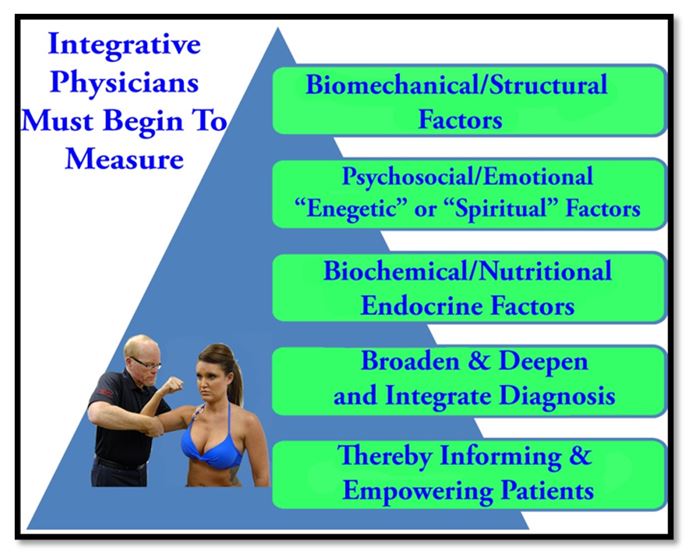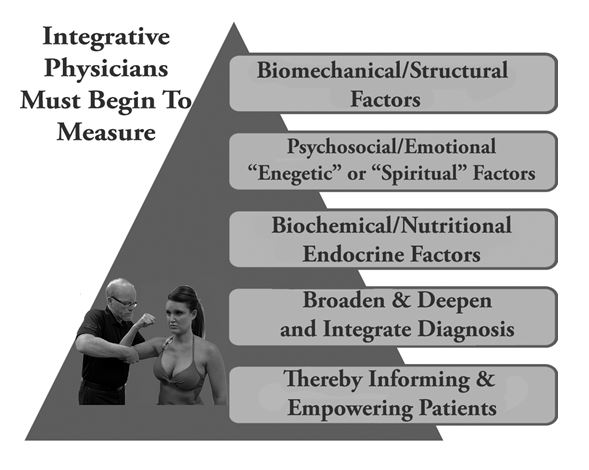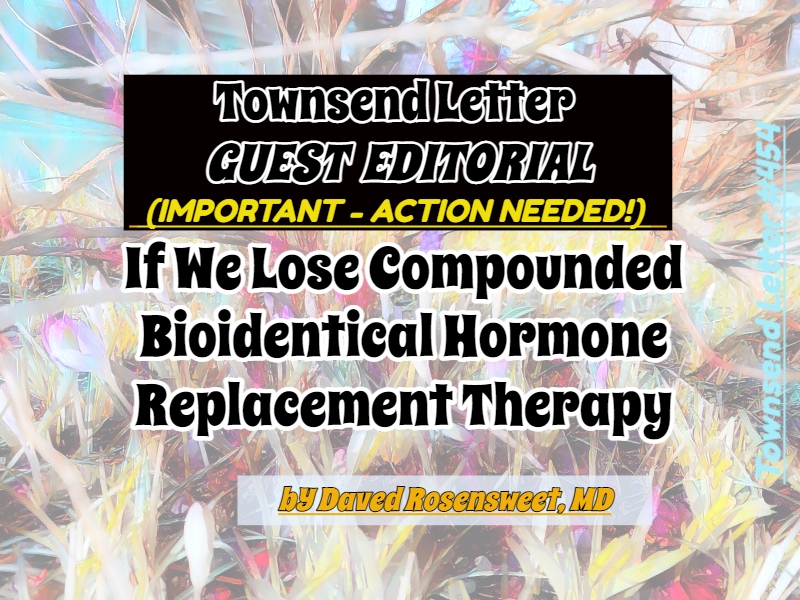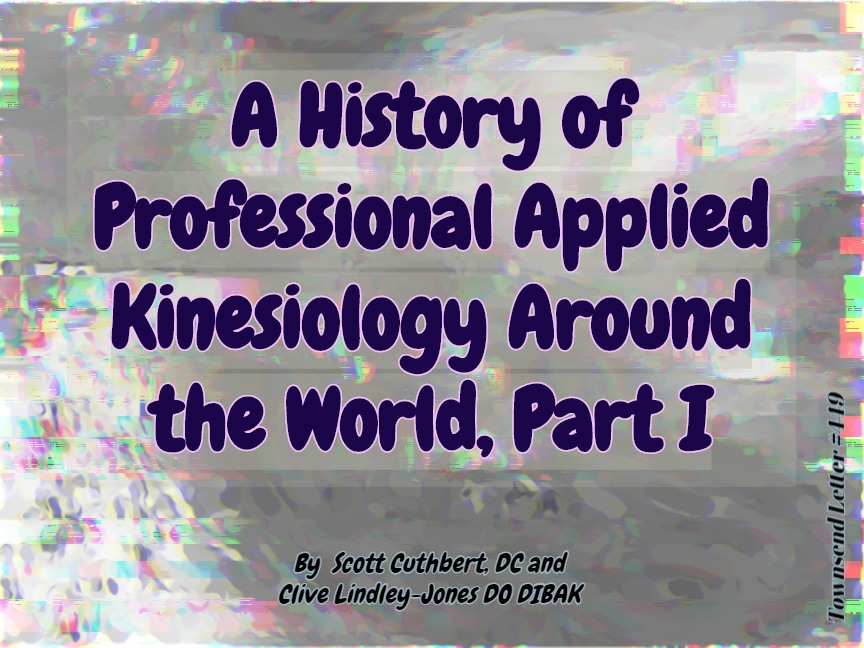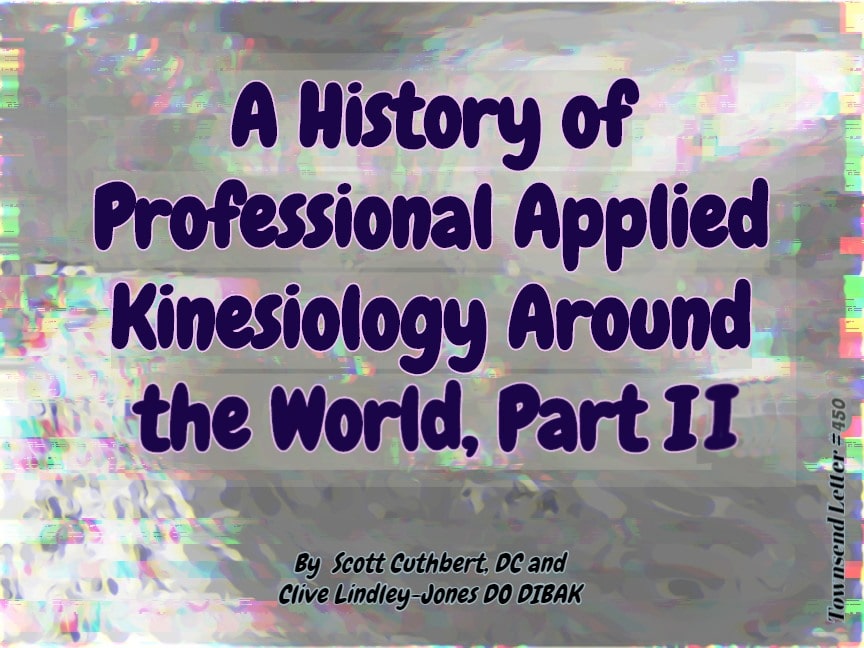…article continued:
Discussion
Applied kinesiology is employed in the treatment of patients with a wide range of diseases and conditions, unrelated to obvious biomechanical problems. This situation emphasizes a basic requirement of AK practice—the necessity to consider the individual features of each patient and condition, and the background of chronic stressors (biomechanical, biochemical, and psychosocial) that a patient brings to the examination. It is also important to recognize that viscerosomatic reflex activity occurring in a patient’s musculoskeletal system may be determined before any symptoms of visceral change are evident and that this phenomenon (the muscle inhibitions resulting from viscerosomatic reflexes) has potential prognostic and diagnostic value.
The methods used in AK for the investigation of digestive dysfunctions and the viscerosomatic or viscero-muscular reflexes involved in these cases have been described by the author previously.2 Applied kinesiology suggests that subluxations might result from three areas of concern, which comprise chemical and mental elements in addition to structural. AK recognizes how nutritional, hormonal, and emotional elements influence neural function as reflected by muscle tone that is evaluated by an established muscle testing protocol whose reliability and validity have been shown.
Applied kinesiology essentially sees the locus of muscle dysfunction ultimately within the nervous system, which brings us back to the founder of chiropractic, D.D. Palmer, and his concept of “tone.” Thus, AK advocates a multi-model program with treatment inclusive of spinal manipulative therapy (SMT) for subluxations, cranial manipulative therapy, specific muscle testing and correction, biochemical evaluation and treatment, and psychosocial evaluation and treatment in order to improve muscle dysfunction (reflective of neural dysfunction) throughout the body in a holistic way.
It was apparent in this case report that altered biochemistry affected this patient’s mood; her altered mood changed her blood chemistry; her altered structure (improved posture from her increased muscle strength and speed) modified her total body function and therefore impacted on her chemistry (e.g., liver function) and potentially on her mood.
An imbalanced estrogen-progesterone ratio is associated with premenstrual syndromes (PMS) and is characterized by mood disorders. The PMS group of symptoms shows water and salt retention, abdominal bloating, mastalgia and weight gain that is associated with high aldosterone levels. This patient suffered most of these signs and symptoms. These kinds of patients are also characterized by blood sugar handling stress (premenstrual craving for sweets — especially chocolate) increased appetite, palpitation, fatigue, headache, and even syncope. Her craving for carbohydrates has improved and is the most likely reason for her weight loss.
PMS is usually associated with persistence of high estrogen after the normal mid-cycle ovulatory spike. This is usually due to insufficient clearance of circulating estrogen by the Phase II detoxification pathway in the liver. An increasing body of scientific data supports the hypothesis that conjugation (sulfation) and deconjugation (desulfation) of estrogens by the liver is important in the regulation of biologically active steroid hormones in target tissues as well.
Cranial treatment for this patient is suggested to have improved the rapidity of her recovery. Clinical observation has shown that the normal function of the motion of the cranial vault up-regulates the function of the neuroendocrine axis, or where the brain folds in upon itself and becomes the endocrine system. This takes place in the middle of the brain and includes the pineal, pituitary, and hypothalamic endocrine glands. These glands are known as the master endocrine control center. These glands control the sleep-wakefulness cycles (or circadian rhythms), reproductive cycles, stress-handling capabilities, and structural integrity.
In this case, functional restoration of the neuroendocrine axis most likely facilitated the return of balance and this patient’s ability to sleep in a normal manner. When it gets dark outside, the pineal gland secretes melatonin, which eventually causes a person to fall asleep. Inadequate stimulation of this gland by lack of cranial motion, may reduce its production of this key hormone, and thus create downstream problems. This treatment should be the very first line of therapy for sleep disorders, as it is simple, cost effective, and non-invasive.
Conclusion
This holistic approach to wellness is the practice of the future as more people focus on preventative, wellness care rather than crisis care. There are today a number of notable institutions and clinic systems growing throughout Asia that have already begun treating and teaching their patients and students using these approaches. The author serves at Intercare Chiropractic Clinics in Makati Manila, the Philippines, where a combination of chiropractic, general medical consultations, rehabilitation and sports medicine, physiotherapy, medical massage and acupuncture are part of the integrative clinical encounter for each patient.23
Countries in the developing world must find ways of building up national resources for prevention, health promotion, and mind/body medicine so that the complexities and causes of functional, chronic illness can be addressed. Throughout the world, resources are constrained and so the ever-growing use of expensive, invasive treatments for functional illnesses is not the best choice for either the first nor the developing world.
From the beginnings of applied kinesiology, practitioners have observed an association between muscle-joint function and visceral-autonomic dysfunction. It is exciting to see accumulating research and developing models from a wide range of academicians and clinicians converging toward concurrence with the field of applied kinesiology.2 This development will, ideally, lead to more coordination with physicians from other fields and backgrounds to work synergistically with clinicians utilizing applied kinesiology methods in the treatment of patients with functional illnesses.
Successful management guided by AK MMT chiropractic methods (involving biomechanical, biochemical, and meridian system factors in the treatment) for a 22-year-old female with a life-long history of hormonal and menstrual irregularities is presented. Four treatments that consisted in the analysis of muscular impairments (inhibition on MMT) and their relationship to organic, articular, soft tissue, hormonal and nutritional disorders, which were treated with chiropractic adjustments, resulted in elimination of the muscle weaknesses found and elimination of years of previous musculovisceral suffering.
Many of these muscular and viscerosomatic impairments have been shown to be reversible: improvements in muscle and hormonal function after chiropractic treatment has been documented in the literature.24 Applied to the general population with endocrine, liver, and digestive dysfunctions, strategies designed to optimize muscle strength and associated autonomic and visceral functional components may have the potential to reduce a vast burden of disability, dependence, and cost.
References
- International College of Applied Kinesiology – U.S.A. [homepage on the internet]. Available at: http://icakusa.com/content/research. (Accessed January 02, 2021)]
- Cuthbert S, Walther DS. Applied Kinesiology Essentials: The Missing Link in Health Care. (2020). Amazon Kindle.
- Cuthbert S, Rosner A, McDowall D. Association of manual muscle tests and mechanical neck pain: results from a prospective pilot study. J Bodyw Mov Ther. 2011 Apr;15(2):192-200.
- Cuthbert SC, Goodheart GJ Jr. On the reliability and validity of manual muscle testing: a literature review, Chiropr Osteopat. 2007; 15(1): 4
- Schmitt WH Jr, Cuthbert SC. Common errors and clinical guidelines for manual muscle testing: “the arm test” and other inaccurate procedures. Chiropr Osteopat. 2008 ;16(1): 16.
- Janda V. Muscle Function Testing. London, UK: Butterworths; 1983:150-222.
- Lewit K. Manipulative Therapy in Rehabilitation of the Locomotor System, 2nd edition. Oxford, UK: Butterworth-Heinemann; 1991:120-124.
- Liebenson C. Ed: Rehabilitation of the Spine: A Practitioner’s Manual, 2nd ed. Philadelphia, PA: Lippincott, Williams & Wilkins; 2007:203-225.
- Motyka TM, Yanuck SF. Expanding the Neurological Examination Using Functional Neurologic Assessment, Part 1: Methodological Considerations. Int J Neurosci 1999;97(1-2):61-76.
- Green GN, Gin RH. George Goodheart, Jr., D.C., and a history of applied kinesiology. J Manipulative Physiol Ther 1997: 20(5): 331-337.
- Schmitt WH, Yanuck SF. Expanding the neurological examination using functional neurological assessment part II: Neurologic basis of applied kinesiology. Int J Neuroscience 1999; 97: 77-108.
- Kendall HO, Kendall FP, Boynton, DA. Posture and Pain. Baltimore, MD: Williams & Wilkins; 1952:77-94.
- Goodheart GJ: Applied Kinesiology Research Manuals. Detroit, MI: Privately published; 1964-1998.
- American Medical Association: Guides to the Evaluation of Permanent Impairment, 5th Edition, Chicago, IL, 2001:510.
- Gelb G. Killing pain without prescription. Appl Kinesiol; 1993:165-172.
- Walther DS. Applied Kinesiology and the Stomatognathic System. IN Gelb H [Ed]. New Concepts In Craniomandibular and Chronic Pain Management. London, UK: Mosby-Wolfe;1994:349-368.
- Schmitt W. Individualized Assessment Using Applied Kinesiology Procedures. IN Bassman L. [Ed.]. The Whole Mind: The Definitive Guide to Complementary Treatments for Mind, Mood, and Emotion. New World Library, 1998:187-207.
- Tiekert, CG. Applied Kinesiology: it’s use in veterinary diagnosis. Vet Med, 1981;76:1621-1623.
- Larson D. Physical balancing: Acupuncture and Applied Kinesiology, Am J Acupunct. 1985;13(2):159-162.
- Gregory WM, Mills, SP, Hamed, H.H., Fentiman IS. Applied kinesiology for treatment of women with mastalgia, Breast, 2001;10(1):15-9.
- Cuthbert S, Lindley-Jones C, et al. A History of Professional Applied Kinesiology Around the World, Part 1 & 2. Townsend Letter: The Examiner of Alternative Medicine. (Dec 2020 & Jan 2021).
- Cuthbert S, Rosner AL. Physical causes of anxiety and sleep disorders: a case report. Altern Ther Health Med. 2011 Nov-Dec;17(6):30-2, 34.
- www.Intercare-centers.com.
- Masarsky, C. S., and Masarsky, M. T. Somatovisceral Aspects of Chiropractic: An Evidence-Based Approach. (Churchill Livingstone, 2001)
- Wang M-Y, et al. Morinda Citrifolia (Noni): a literature review and recent advances in Noni research. Acta Pharmacol Sin. 2002 Dec.
- Therapy localization is a diagnostic procedure unique to AK that consists of placing the patient’s hand over areas of suspected involvement and observing for a change in the MMT. This method assists the doctor in rapidly finding areas that are involved with the muscle dysfunction found on MMT and has been used clinically for nearly 40 years. Cuthbert et al, Rosner et al, and Pollard et al in recent literature reviews outlined the research supporting the AK concept of therapy localization. Collectively these data suggest that stimulating or stabilizing the muscles, joints, ligaments, and skin — and their associated cutaneomotor reflexes — can produce changes in muscle function.
History of Professional Applied Kinesiology Around the World


